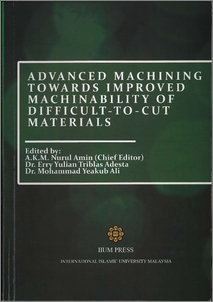Amin, A. K. M. Nurul and A., Abu and D. , Salha A. and S. , Salhana B.
(2011)
Influence of chatter on tool life during end milling of Aluminium and Aluminium alloy on vertical machining centre (VMC).
In:
Advanced Machining Towards Improved Machinability of Difficult-to-Cut Materials.
IIUM Press, Kuala Lumpur, Malaysia, pp. 75-82.
ISBN 9789674181758
![[img]](http://irep.iium.edu.my/style/images/fileicons/application_pdf.png)  Preview |
|
PDF (Influence of chatter on tool life during end milling of Aluminium and Aluminium alloy on vertical machining centre (VMC))
- Published Version
Download (547kB)
| Preview
|
Abstract
Cutting tools are subjected to severe stress-strain conditions due to cutting forces, heat
generated and vibrations caused during machining. These conditions affect the overall
performance of the tool. Wear is the major concern in metal cutting and since it affects the
productivity and dimensional accuracy of the machined part. Intensive chatter vibrations are a
major concern during metal cutting in most of the cases at high cutting speeds. It leads to lower
life of machine tools elements, lower machining accuracy and surface finish, and higher rate of
tool wear are caused by chatter. Apart from that high noise level, associated with chatter, is
generally uncomfortable for the operator. There are various theories on the formative
mechanism of chatter. However Talantov and Amin established quite convincingly that, during
turning chatter occurs when the frequency of the cyclic or the serrated chip elements coincides
with the natural frequency of the individual components of the machine-tool system, like tool
holder, spindle, etc. [1,2]. During resonance the frequency of the vibration remains practically
constant and the amplitude increases to a maximum value and then gradually decreases when
the component gets out of the resonance. Trent has also concluded that the formation of
serrated chips during metal cutting leads to chatter of machine tools [3]. Increasing cutting
force contributes to intensification of chatter. Chatter can be reduced by changing cutting
parameters [4]. This work aims at studing the influence of cutting parameters on chatter to
minimize chatter effects on tool wear and at developing a chart of recommended cutting
conditions for the given materials to facilitate almost chatter free machining with satisfactory
surface finish and tool life.
Actions (login required)
 |
View Item |


 Download Statistics
Download Statistics Download Statistics
Download Statistics